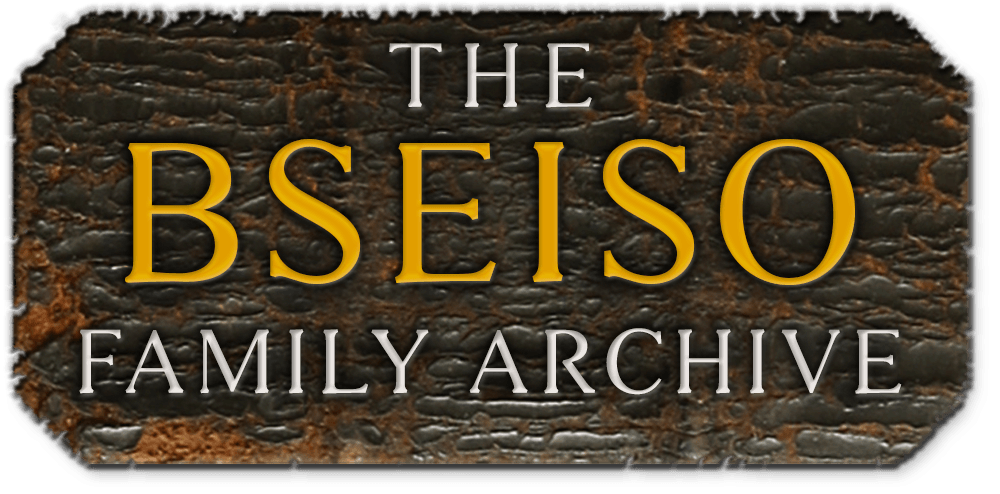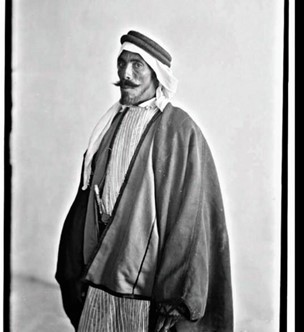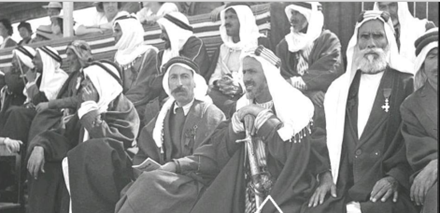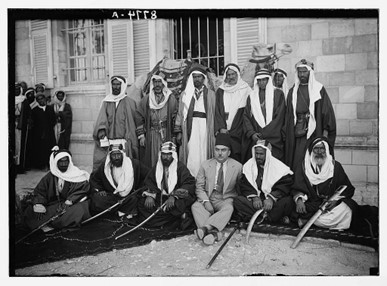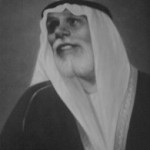Witnesses
Auda bin Jukhaydem
|
He is a witness to a number of contracts (including 0005, 0023). Auda was the Sheikh of Al-Mohammadeen Tribe from the Al-Azazmeh. He took this sheikhdom after his father. Outside sources show his name among prominent figures in Beersheba who were involved in Palestinian politics in the 1930’s along with Abdulrazzaq Abu Sitta (cf: Salman Abu Sitta). After 1948, he and his tribe relocated to Jordan where he lived in Amman. |
Auda Abu Al-Khayl |
He is a witness mentioned in document 0005. He is the sheikh Al-Sawakhneh Al-Azazmeh. He assumed the Sheikhdom position in 1920 and passed away in the 1950’s. His descendants remain in the Beersheba area. Outside sources show his name among prominent figures in Beersheba who were involved in Palestinian politics in the 1930’s along with Abdulrazzaq Abu Sitta. |
Harb Abu Ruqayiq
|
He was the Sheikh of the Al-Qudairat tribe. Being the Sheikh, he had considerable influence in the area. Sources mention his name among the receiving party of Prince Abdullah in Gaza in 1934. He is also mentioned as the owner of purebred Arabian horses that participated in the Jaffa horse races between 1930-1935 (see picture). He was forced to relocate to Jordan after 1948; his descendants remain in Beersheba. |
Shaaban Bseiso |
He is mentioned in multiple documents as a witness and a seller (0030). He was Mahrous’s brother. |
Mohammad Suleiman al-Nuairy |
He is the seller in document 0022. He is the son of Sheikh Suleiman Al-Nuairy |
Suleiman Abu-Ghalyoun
|
He is mentioned as owning land bordering the property being sold in document 0027. Being a Sheikh of his tribe, his name is mentioned in outside sources as being involved in the politics of Palestine during the 1930’s. He is pictured here (fourth, standing) with Arif Al-Arif and other Sheikhs of the Beersheba area. He is also mentioned in this British court order in Jerusalem from 1939. |
Mohammad Shaker Hirzallah |
A major businessman and landowner in Beersheba at the time. He is originally from Gaza. Sources indicate that he sold his property in Beersheba (including properties in documents 0037, 0043, 0053) before relocating to Gaza in the mid 1940’s. There is little information available about him after that, but his son Sa’adeddine and his descendants live in Amman, Jordan. |
Salam Abu Mahfouz |
He is mentioned as a witness in document 0037. He was a Sheikh of the Abu Mahfouz tribe (Al-Mahafzeh). He and his tribe were removed from their homes post 1948 from the village of Tell es-Seba (a.k.a Tell Abu Mahfouz). |
Sheikh Eid Musallam Bin Khudayrah |
He is mentioned as a witness to document 0037. He was the Sheikh of the Farahin tribe that lived in and around Beersheba. |
Eissa Bseiso |
He is the seller in document number 0039. He is the brother of Mahrous Bseiso. Sources indicate that he built one of the two main mosques in Beersheba in 1931 (the other having been built by the Ottomans). Eissa was the father of Dr. Saadi Bseiso (1902-2001), a renowned jurisprudent academic and politician in the Middle East. |
Arif Ali Al-Najjar |
He is mentioned in document 0047 as the co-owner of properties (with Jawdat Mahrous Bseiso (1924-2003), Mahrous’ son and right-hand man). Arif was a prominent businessman in Palestine in the 1940s. He was also involved in the political scene at the time. He published a newspaper (Al-Qarya Al-Arabiya “The Arab Town”) in Jerusalem in 1946. His son in law, Yahya Hammuda, rose to prominence and was for a short period of time the chairman of the PLO. Arif’s descendants live in Jordan. One of his daughters, Taghreed Al-Najjar, was a major fiction author. |
عودة بن جخيديم
|
هو شاهد على عدد من العقود (بما في ذلك 0005 ، 0023). كان عودة شيخ قبيلة المحمدين من العزازمة. تولى هذه المشيخة بعد والده. تظهر مصادر خارجية اسمه بين الشخصيات البارزة في بئر السبع الذين انخرطوا في السياسة الفلسطينية في الثلاثينيات إلى جانب عبد الرزاق أبو ستة (راجع: سلمان أبو ستة). بعد عام 1948، انتقل هو وقبيلته إلى الأردن حيث عاش في عمان. |
| عودة ابو الخيل | هو شاهد مذكور في الوثيقة رقم 0005 وهو شيخ السواخنة العزازمة. تولى منصب المشيخة عام 1920 وتوفي عام 1950. وبقي نسله في منطقة بئر السبع. تظهر مصادر خارجية اسمه بين الشخصيات البارزة في بئر السبع الذين انخرطوا في السياسة الفلسطينية في الثلاثينيات إلى جانب عبد الرزاق أبو ستة. |
حرب ابو رقيق
|
كان شيخ قبيلة القديرات. وبكونه شيخاً، كان له تأثير كبير في المنطقة. وتذكر المصادر اسمه ضمن من استقبلوا الأمير عبد الله في غزة عام 1934. كما ورد اسمه على أنه مالك للخيول العربية الأصيلة التي شاركت في سباقات خيول يافا بين 1930-1935 (انظر الصورة). اضطر للانتقال إلى الأردن بعد عام 1948. نسله في بئر السبع. |
| شعبان بسيسو | مذكور في وثائق متعددة كشاهد وبائع (0030). كان شقيق محروس. |
| محمد سليمان النويري | هو البائع في الوثيقة 0022. هو نجل الشيخ سليمان النويري |
|
سليمان أبو غليون
|
ورد ذكره على أنه مالك للأرض المجاورة للممتلكات المباعة في الوثيقة 0027. وكونه شيخًا في قبيلته، فقد ورد اسمه في مصادر خارجية على أنه مشارك في السياسة الفلسطينية خلال الثلاثينيات. يظهر في الصورة هنا (الرابع، واقفًا) مع عارف العارف وشيوخ آخرين في منطقة بئر السبع. وهو مذكور أيضًا في أمر المحكمة البريطانية هذا في القدس منذ عام 1939. |
|
محمد شاكر حرزالله |
رجل أعمال كبير ومالك أرض في بئر السبع في ذلك الوقت. أصله من غزة. تشير المصادر إلى أنه باع ممتلكاته في بئر السبع (بما في ذلك العقارات في الوثائق 0037، 0043، 0053) قبل الانتقال إلى غزة في منتصف الأربعينيات. المعلومات المتوفرة عنه قليلة بعد ذلك، لكن نجله سعد الدين وذريته يعيشون في عمان، الأردن. |
سلام ابو محفوظ |
ورد كشاهد في الوثيقة 0037. كان شيخ قبيلة أبو محفوظ (المحافظة). تم إبعاده وقبيلته من منازلهم بعد عام 1948 من قرية تل السبع (تل أبو محفوظ). |
|
الشيخ عيد مسلم بن خضيره |
تم ذكره كشاهد على وثيقة 0037. كان شيخ قبيلة الفراحين التي كانت تعيش في بئر السبع وما حولها. |
|
عيسى بسيسو |
هو البائع في الوثيقة رقم 0039. وهو شقيق محروس بسيسو. تشير المصادر إلى أنه بنى أحد المسجدين الرئيسيين في بئر السبع عام 1931 (والآخر بناه العثمانيون). عيسى هو والد الدكتور سعدي بسيسو (1902-2001)، الذي كان أكاديمي وسياسي شهير في الشرق الأوسط. |
|
عارف علي النجار |
ورد في الوثيقة 0047 بصفته الشريك في ملكية العقارات (مع جودت محروس بسيسو (1924-2003)، ابن محروس وذراعه الأيمن). كان عارف رجل أعمال بارزًا في فلسطين في الأربعينيات. كما شارك في المشهد السياسي في ذلك الوقت. أصدر صحيفة (القرية العربية) في القدس عام 1946. برز صهره يحيى حمودة وكان لفترة وجيزة رئيس منظمة التحرير الفلسطينية. أحفاد عارف يعيشون في الأردن. كانت إحدى بناته، تغريد النجار ، مؤلفة روائية كبيرة. |
Witnesses
Auda bin Jukhaydem |
He is a witness to a number of contracts (including 0005, 0023). Auda was the Sheikh of Al-Mohammadeen Tribe from the Al-Azazmeh. He took this sheikhdom after his father. Outside sources show his name among prominent figures in Beersheba who were involved in Palestinian politics in the 1930’s along with Abdulrazzaq Abu Sitta (cf: Salman Abu Sitta). After 1948, he and his tribe relocated to Jordan where he lived in Amman. |
Auda Abu Al-Khayl |
He is a witness mentioned in document 0005. He is the sheikh Al-Sawakhneh Al-Azazmeh. He assumed the Sheikhdom position in 1920 and passed away in the 1950’s. His descendants remain in the Beersheba area. Outside sources show his name among prominent figures in Beersheba who were involved in Palestinian politics in the 1930’s along with Abdulrazzaq Abu Sitta. |
Harb Abu Ruqayiq |
He was the Sheikh of the Al-Qudairat tribe. Being the Sheikh, he had considerable influence in the area. Sources mention his name among the receiving party of Prince Abdullah in Gaza in 1934. He is also mentioned as the owner of purebred Arabian horses that participated in the Jaffa horse races between 1930-1935 (see picture). He was forced to relocate to Jordan after 1948; his descendants remain in Beersheba. |
Shaaban Bseiso |
He is mentioned in multiple documents as a witness and a seller (0030). He was Mahrous’s brother. |
Mohammad Suleiman al-Nuairy |
He is the seller in document 0022. He is the son of Sheikh Suleiman Al-Nuairy |
Suleiman Abu-Ghalyoun |
He is mentioned as owning land bordering the property being sold in document 0027. Being a Sheikh of his tribe, his name is mentioned in outside sources as being involved in the politics of Palestine during the 1930’s. He is pictured here (fourth, standing) with Arif Al-Arif and other Sheikhs of the Beersheba area. He is also mentioned in this British court order in Jerusalem from 1939. |
Mohammad Shaker Hirzallah |
A major businessman and landowner in Beersheba at the time. He is originally from Gaza. Sources indicate that he sold his property in Beersheba (including properties in documents 0037, 0043, 0053) before relocating to Gaza in the mid 1940’s. There is little information available about him after that, but his son Sa’adeddine and his descendants live in Amman, Jordan. |
Salam Abu Mahfouz
|
He is mentioned as a witness in document 0037. He was a Sheikh of the Abu Mahfouz tribe (Al-Mahafzeh). He and his tribe were removed from their homes post 1948 from the village of Tell es-Seba (a.k.a Tell Abu Mahfouz). |
Sheikh Eid Musallam Bin Khudayrah |
He is mentioned as a witness to document 0037. He was the Sheikh of the Farahin tribe that lived in and around Beersheba. |
Eissa Bseiso |
He is the seller in document number 0039. He is the brother of Mahrous Bseiso. Sources indicate that he built one of the two main mosques in Beersheba in 1931 (the other having been built by the Ottomans). Eissa was the father of Dr. Saadi Bseiso (1902-2001), a renowned jurisprudent academic and politician in the Middle East. |
Arif Ali Al-Najjar |
He is mentioned in document 0047 as the co-owner of properties (with Jawdat Mahrous Bseiso (1924-2003), Mahrous’ son and right-hand man). Arif was a prominent businessman in Palestine in the 1940s. He was also involved in the political scene at the time. He published a newspaper (Al-Qarya Al-Arabiya “The Arab Town”) in Jerusalem in 1946. His son in law, Yahya Hammuda, rose to prominence and was for a short period of time the chairman of the PLO. Arif’s descendants live in Jordan. One of his daughters, Taghreed Al-Najjar, was a major fiction author. |
